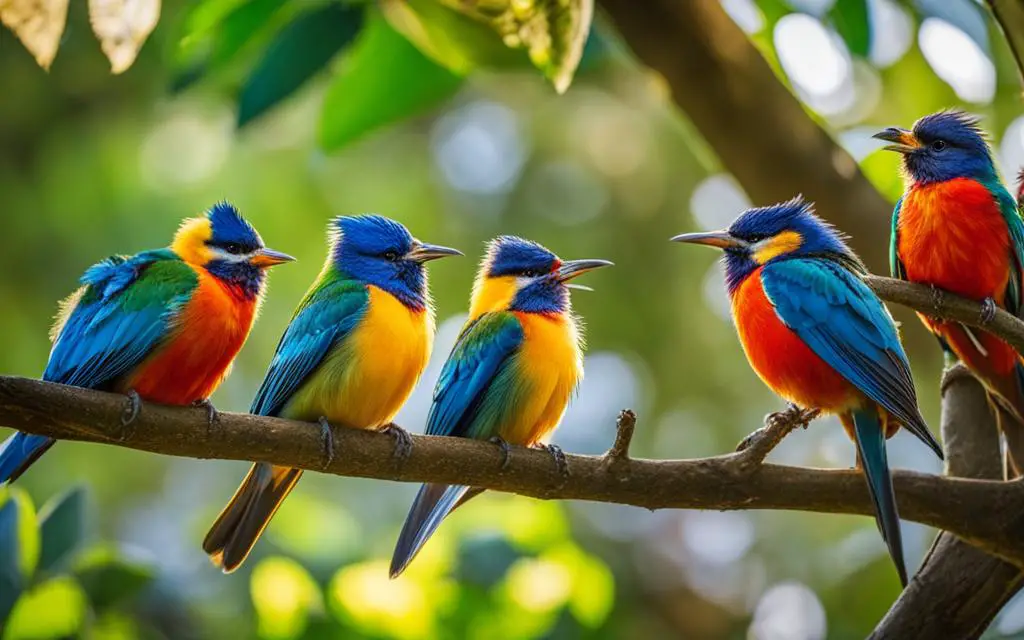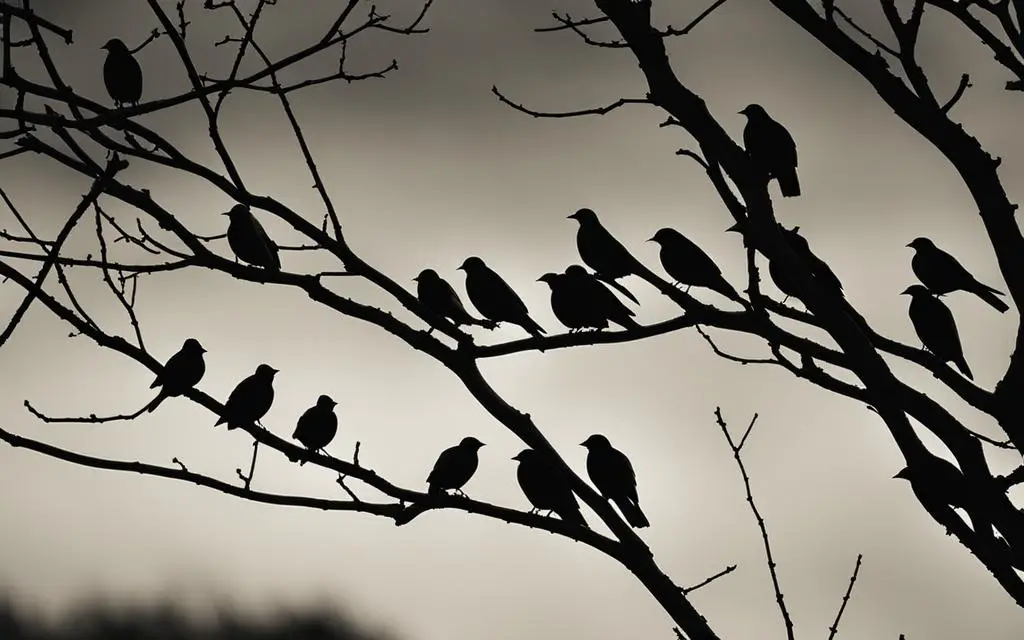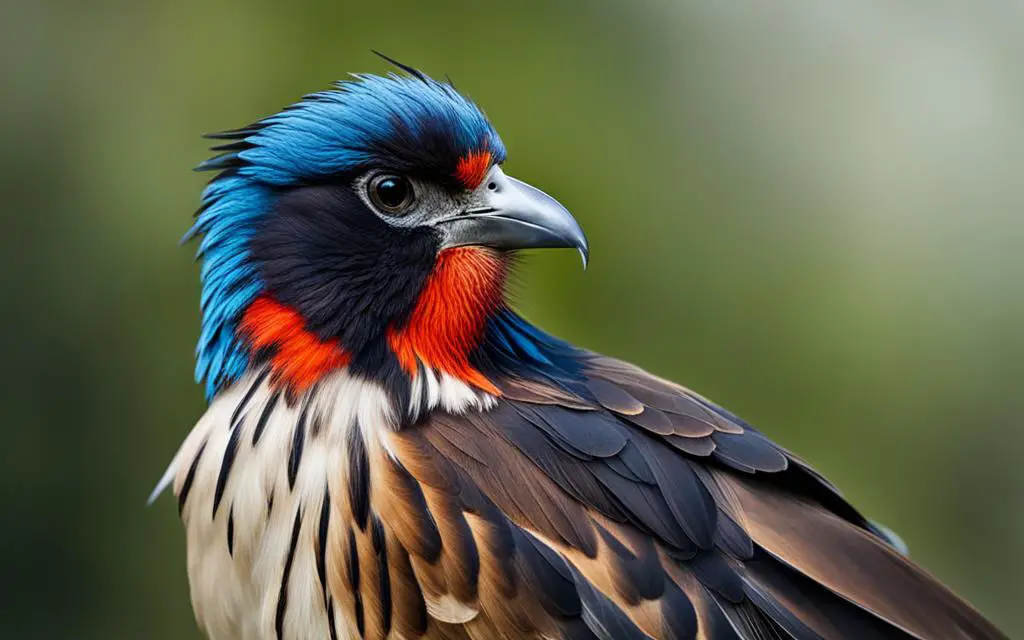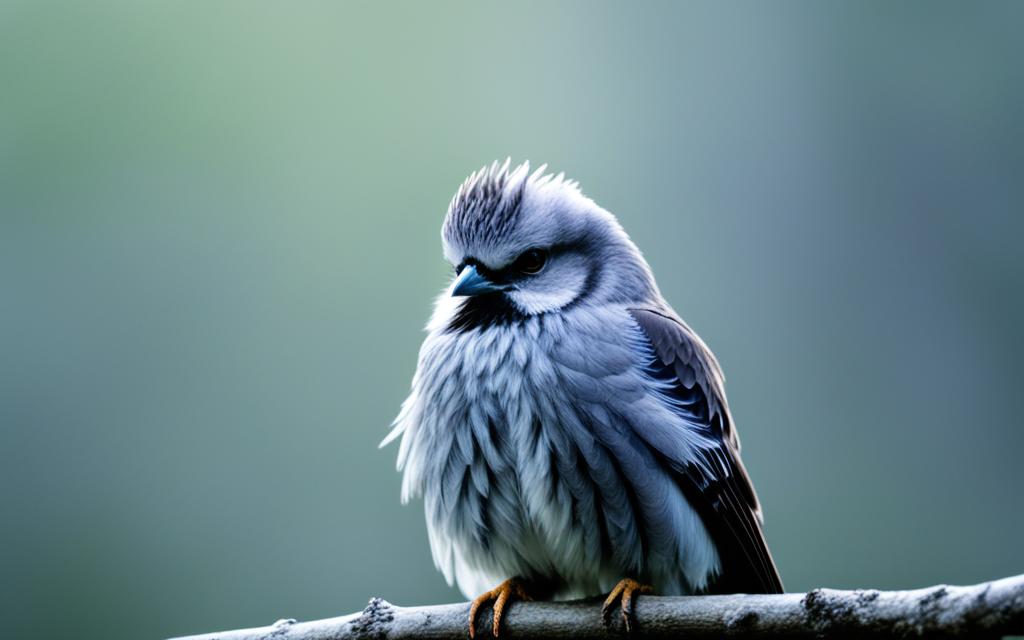When it comes to the emotional lives of birds, there is still much to discover and understand. One question that has intrigued scientists and bird enthusiasts alike is whether birds mourn the loss of their mate. While it is a topic that sparks ongoing debate, there is compelling evidence that suggests birds do indeed experience grief and mourning.
Observations of bird behavior in the wild and in captivity have provided valuable insights into the coping mechanisms and emotional impact of losing a mate. From altered behavior to signs of sadness, the avian world exhibits fascinating grieving patterns that shed light on the rich emotional lives of these incredible creatures.
In this article, we will explore the behaviors and emotions exhibited by birds after the loss of a mate. We will delve into the psychological impact of losing a mate, examine mourning rituals in bird communities, and gain a deeper understanding of how birds navigate the grieving process.
Key Takeaways:
- Birds form deep emotional bonds with their mates.
- Scientific evidence suggests that birds experience grief and mourning.
- Bird behavior after losing a mate includes altered behavior and signs of sadness.
- Understanding bird emotions after loss can help provide support and comfort.
- Mourning rituals are observed in bird communities and can vary among avian species.
Understanding Avian Behavior and Emotions
Birds, with their complex brains similar to primates, possess advanced cognitive abilities and socialization skills. They are capable of forming strong emotional bonds, just like humans. These emotional connections are often observed in their behavior, indicating that birds may experience a wide range of emotions, including grief and joy.
One of the most prominent examples of avian behavior that suggests emotional experiences is the expression of grief after the loss of a mate. When a bird loses its partner, it can exhibit signs of sadness and mourning. These signs may include altered behavior, such as decreased appetite, increased vocalizations, and pacing. Some birds even participate in mourning rituals and remain near the deceased bird’s body for extended periods.
On the other end of the emotional spectrum, birds also display joyful behavior. They engage in activities that seem to bring them pleasure, such as singing, playing, and engaging in social interactions. These expressions of joy are similar to human experiences of happiness and indicate that birds are capable of experiencing positive emotions.
In addition to the behavioral evidence, there is scientific evidence that supports the idea of birds experiencing emotions. Studies have shown that birds possess brain structures and chemicals associated with emotions, such as dopamine and opioids. These findings suggest that birds may have the capacity to experience emotions in a manner similar to humans.
Overall, the intricate socialization and cognitive abilities of birds, as well as their complex responses and similarities to human cognition, indicate that they can form emotional bonds and experience a range of emotions. By understanding avian behavior and emotions, we can gain a deeper appreciation for the rich emotional lives of these fascinating creatures.
The Cognitive Abilities of Birds
In recent years, research has revealed the impressive cognitive abilities of birds. They have shown capabilities in problem-solving, tool use, and even numerical reasoning. These findings further support the notion that birds possess complex cognitive processes and intellectual capacities.
Signs of Mourning in Birds
When it comes to the loss of a mate, birds can display a range of behaviors that suggest they are experiencing mourning. These signs serve as a testament to the depth of emotional connections formed among avian species. Observing these altered behaviors can help us understand the emotional distress birds may undergo during such periods.
One of the most common signs of mourning in birds is a decreased appetite. Similar to humans, birds may lose interest in food when they are grieving, leading to weight loss and a decline in overall health. This change in eating behavior is particularly noticeable since birds are typically voracious eaters.
Another prominent sign of mourning is increased vocalization. Birds may become more vocal after the loss of a mate, producing louder and more frequent sounds. This heightened expression of their voice could be an attempt to communicate their distress or a way to seek comfort from their surroundings.
In addition to changes in appetite and vocalizations, mourning birds may exhibit pacing and altered behavior. They might display restless movements, constantly moving around their environment in a seemingly aimless manner. This behavior is believed to be a manifestation of their emotional turmoil and the struggle to adapt to life without their mate.
Aggression is also observed in mourning birds. They may become more irritable and easily provoked, lashing out at other birds or even humans. This aggression could be a reflection of their emotional distress, as they try to establish a sense of control in their altered reality.
Birds that experience prolonged signs of grief may engage in mourning rituals. For example, some birds have been observed circling around the fallen bird’s body, possibly as a way to pay homage or acknowledge the loss. This behavior emphasizes the depth of emotion experienced by these grieving birds.
In addition to the visible signs mentioned above, birds in mourning may also show emotional distress through changes in posture, appearing droopy and listless. They may exhibit a refusal to eat, demonstrating a loss of interest or motivation. These prolonged signs of grief highlight the complex emotional lives of birds and their ability to experience profound sadness after the loss of a mate.
| Signs of Mourning in Birds |
|---|
| Decreased appetite |
| Increased vocalization |
| Pacing and altered behavior |
| Aggression |
| Mourning rituals |
| Changes in posture and listlessness |
| Refusal to eat |
Expressions of Joy in Birds
Just like humans, birds are capable of experiencing joy and happiness. Research has shown that birds have specific brain receptors for dopamine and opioids, which are closely associated with feelings of pleasure and joy [1]. These receptors play a crucial role in the birds’ ability to experience and express happiness.
When birds are happy, they exhibit various behaviors that indicate their joy. One of the most common signs of happiness in birds is singing. Birds have beautiful voices, and their songs are often a reflection of their joyful state. Whether it’s a melodious tune or a cheerful chirp, their singing is a clear expression of their happiness [2].
“Birds have a unique capacity for joyful play and engagement in a wide range of activities purely for enjoyment. They engage in playful behaviors that are reminiscent of surfing waves or sliding down slopes, which further highlights their happiness-inducing experiences”, says Dr. Avian Behaviorist.

Playing is another behavior that birds engage in when they are happy. Whether it’s playing with toys, interacting with their environment, or engaging in social play with other birds, these activities bring them immense pleasure and satisfaction. It’s a joyful way for birds to express themselves and enjoy their surroundings.
Additionally, birds’ body language can provide valuable insights into their happiness. When a bird is content and joyful, you may notice a relaxed posture, fluffed feathers, and bright, alert eyes. They may also engage in rapid wing movements or hop around energetically, showcasing their excitement and happiness [3].
“Birds are amazing creatures that experience a wide range of emotions, including joy. Observing their expressions of happiness can bring us joy as well, and it’s a reminder of the beauty and wonder of the natural world around us.”
Happiness-Inducing Activities for Birds
If you want to ensure your feathered friend’s happiness, providing them with activities that stimulate their natural instincts and curiosity is key. Some happiness-inducing activities for birds include:
| Activity | Description |
|---|---|
| Foraging | Hide treats or food in various locations within their enclosure to encourage natural foraging behavior. |
| Environmental Enrichment | Provide toys, puzzles, and climbing structures to keep your bird mentally and physically stimulated. |
| Flight Time | Allow your bird to have regular supervised flight sessions in a safe and secure space. |
| Socialization | Arrange playdates or social interactions with other compatible birds to fulfill their social needs. |
By incorporating these happiness-inducing activities into your bird’s daily routine, you can provide them with a fulfilling and joyful life. Remember, birds are intelligent creatures with rich emotional lives, and it’s our responsibility to ensure their well-being and happiness.
[1] Research on bird brain chemistry and emotions
[2] Behavioral observations of joyful bird vocalizations
[3] Profiling bird body language and expressions of joy
Fearful Reactions in Birds
Fear is a natural instinct in birds and plays a crucial role in their survival. When faced with potential threats, birds exhibit various reactions to protect themselves and their offspring. Understanding these fearful behaviors can provide valuable insights into their predator avoidance strategies and overall survival.
Predator Avoidance Behaviors
Birds have developed sophisticated predator avoidance behaviors that help them evade potential threats. When encountering danger, their first instinct is to fly away swiftly and seek shelter in nearby trees, bushes, or other protective environments. This quick escape allows them to create distance between themselves and the threat, reducing the risk of predation.
Additionally, birds employ a range of defensive behaviors to deter predators and increase their chances of survival. Some species may make themselves look larger by spreading their wings, puffing up their feathers, or extending their necks to intimidate or frighten away potential attackers.
Distress Calls
One common reaction to fear in birds is the emission of distress calls. These calls serve as alarm signals to other individuals in the vicinity, warning them of impending danger. By communicating the presence of a threat, birds can coordinate their responses and increase their collective chances of survival.
“The distress calls of birds are often sharp and loud, designed to grab the attention of other members of their species. These calls can be highly effective in alerting nearby birds to the presence of potential danger, allowing them to take appropriate defensive measures.”
Distracting Behaviors
In addition to fleeing and emitting distress calls, birds may also engage in distracting behaviors to divert the attention of predators away from their nests or offspring. These behaviors can include exaggerated displays, such as feigning injury or performing elaborate courtship rituals, to draw the predator’s focus away from vulnerable areas.
“Distracting behaviors in fearful birds are fascinating to observe. They demonstrate the adaptability and intelligence of birds in utilizing deceptive tactics to protect their nests and young.”
By employing distracting behaviors, birds are able to increase their chances of survival by deflecting the predator’s attention and reducing the risk of their nests or young being discovered and targeted.

Anger and Aggression in Birds
When it comes to defending their territory and protecting their offspring, birds can experience anger and display aggressive behavior. This natural response is essential for ensuring the survival of their nests and offspring.
One common manifestation of aggressive behavior in birds is warning displays. Birds may engage in posturing by spreading their wings or fluffing their feathers to intimidate intruders. These displays can serve as a clear warning sign, signaling potential predators or competing birds to stay away.
Vocalizations also play a significant role in birds’ aggressive behavior. They may let out loud calls or shrieks to deter threats and mark their territory. These vocalizations communicate their dominance and assert their presence.
Some bird species take their aggression a step further by dive-bombing intruders. They swoop down from above, often targeting predators or perceived threats with precision and force. This behavior aims to startle and scare off the intruder, protecting their territory.
Additionally, aggressive body language in birds is a crucial aspect of their territorial defense. They may adopt defensive postures, such as leaning forward or lowering their bodies to appear larger and more intimidating. Some species even flash their colorful feathers as a warning, showcasing their aggression and potential for harm.

Understanding and recognizing these aggressive behaviors in birds is essential for deciphering their intentions and avoiding potential conflicts. It also offers valuable insights into their innate instincts and the measures they take to safeguard their nests and offspring.
Grief and Mourning Behaviors
Birds, like humans, can experience grief and exhibit mourning behaviors that are similar to human expressions of sadness and mourning. When a bird loses its mate, it may display various grieving behaviors that indicate its emotional distress and the depth of its attachment.
One common grieving behavior in birds is a drooping posture. When birds are mourning, they may slouch down, with their feathers puffed up and their heads hanging low. This posture signifies their sadness and can be seen as a physical representation of their emotional state.
Another sign of grief in birds is listlessness. Mourning birds may become lethargic and lose interest in their surroundings. They may appear disinterested in food, toys, or social interactions, preferring to spend most of their time alone.

In some cases, birds may even cry tears as a way of expressing their grief. Although their tears may not be comparable to human tears, the act of shedding tears is symbolic of the emotional pain they are experiencing.
Refusing to eat is another common mourning behavior in birds. Loss of appetite is a clear indication of their sadness and can last for an extended period. This refusal to eat can be distressing for bird owners, as it may lead to weight loss and a decline in their overall health.
Mourning rituals are another fascinating aspect of grief in birds. Some birds engage in rituals such as walking in circles around the fallen bird or remaining near the deceased bird’s body for an extended period. These rituals demonstrate their emotional attachment and deep sense of loss.
To better understand the grieving behaviors in birds, let’s take a closer look at a table that summarizes the signs of grief and mourning in avian species:
| Grieving Behaviors | Description |
|---|---|
| Drooping posture | Birds slouch down, feathers puffed up, and heads hanging low |
| Listlessness | Birds become lethargic, disinterested, and prefer solitude |
| Tears | Birds cry tears as an expression of emotional pain |
| Refusing to eat | Birds lose their appetite and may experience weight loss |
| Mourning rituals | Walking in circles around the fallen bird or staying near the deceased bird’s body |
These behaviors collectively demonstrate the profound impact that the loss of a mate can have on a bird’s emotional well-being. Mourning is a complex process for birds, just as it is for humans, and understanding their grief can help us provide the support and comfort they need during such challenging times.
Helping a Grieving Bird
When a bird is grieving the loss of a mate, it is essential for us to provide a safe and comforting environment to support their healing process. Here are some ways we can assist a grieving bird:
Creating a Safe Environment
To begin, it is important to create a calm and quiet space for the grieving bird. Find a peaceful area within their habitat where they can feel secure and undisturbed. Minimizing noise and external stimuli can help reduce stress and anxiety during this sensitive time.
Providing Comfort and Support
Offering comfort and support is vital for a grieving bird. Spend extra time with them, providing companionship and reassurance. Engage in activities that they enjoy, such as gentle play or singing together. This can help distract them from their sadness and provide them with a sense of comfort and normalcy.
Maintaining a Consistent Routine
Keeping a consistent routine is crucial for a grieving bird. Stick to their regular feeding and sleeping schedule as much as possible, as this can help them feel secure and maintain a sense of stability. Consistency in their daily activities can go a long way in providing comfort during the grieving process.
Consulting a Bird Behaviorist
If you are unsure about how to support a grieving bird or notice any concerning behavior, it may be beneficial to consult with an experienced bird behaviorist. They can provide expert guidance tailored to your bird’s specific needs and help ensure their emotional well-being is properly addressed.
Remember, supporting a grieving bird requires patience, understanding, and love. By creating a safe and nurturing environment, providing comfort, maintaining a routine, and seeking professional advice when needed, we can help our feathered friends navigate the challenging journey of grief and find solace in time.
| Ways to Help a Grieving Bird | Benefits |
|---|---|
| Create a safe environment | Reduces stress and anxiety |
| Provide comfort and support | Offers emotional reassurance |
| Maintain a consistent routine | Promotes a sense of stability |
| Consult a bird behaviorist | Expert guidance for specific needs |
Conclusion
While there is ongoing scientific debate about the exact nature of avian emotions, there is substantial evidence to suggest that birds experience grief and mourning. The behaviors observed in birds after the loss of a mate, such as altered behavior and participation in mourning rituals, mirror the expressions of sadness that humans display. Understanding these emotions is crucial for supporting and comforting our feathered companions during times of loss.
By creating a nurturing environment and maintaining a consistent routine, we can help our grieving birds navigate the process of grief. Providing a calm and quiet space, ensuring proper nutrition and hydration, and offering extra attention and interaction are all essential steps in supporting a grieving bird. Additionally, engaging in low-stress activities can help distract the bird from sadness and promote healing.
While the complexities of avian emotions require further research, acknowledging and respecting the grief experienced by our bird companions is an important aspect of responsible pet ownership. By acknowledging and understanding their emotions, we can provide the support and comfort that our grieving birds need to cope with their loss, ultimately facilitating their journey towards healing.
FAQ
Do birds mourn the loss of their mate?
While there is ongoing debate among scientists about whether birds experience grief and mourning, there are numerous instances that suggest they do. Observations of bird behavior, both in the wild and in captivity, provide evidence of mourning rituals, altered behavior, and signs of sadness after the loss of a mate.
What behaviors indicate that birds experience mourning?
Signs of mourning in birds include decreased appetite, increased vocalization, pacing, aggression, and altered behavior. Some birds may also exhibit prolonged signs of grief, such as remaining near the deceased bird’s body or participating in mourning rituals like circling around the fallen bird.
Do birds experience joy?
Yes, birds show signs of happiness through behaviors such as singing, playing, and engaging in activities purely for enjoyment. Playful behaviors, like sliding down slopes or surfing waves, have been observed in birds and indicate their capacity for experiencing joy.
How do birds react when they are fearful?
When birds are fearful, they display behaviors such as flying away, chirping distress calls, and creating distractions to lure predators away from the nest. They may also exhibit defensive behaviors, such as making themselves look larger or engaging in warning displays to protect themselves and their offspring.
Can birds experience anger?
Yes, birds can experience anger and display aggressive behaviors when they feel their territory or offspring are threatened. Warning displays, posturing, and vocalizations are common aggressive behaviors in birds. Some birds may even dive-bomb intruders or flash their colorful feathers as a warning.
What are the grieving behaviors in birds?
Birds exhibit various grieving behaviors that resemble human expressions of sadness and mourning. These behaviors include drooping posture, listlessness, crying tears, and refusing to eat. Some birds engage in mourning rituals, such as walking in circles around a fallen bird or remaining near the deceased bird’s body for extended periods.
How can I help a grieving bird?
When a bird is grieving the loss of a mate, providing a safe and comfortable environment is crucial. This includes creating a calm and quiet space, ensuring proper nutrition and hydration, and offering extra attention and interaction. Maintaining a routine can help a grieving bird feel secure, and engaging in low-stress activities can distract from sadness.
Do birds experience emotions similar to humans?
While the scientific community continues to debate the exact nature and extent of emotions in birds, there is compelling evidence that they do experience grief and mourning. Birds exhibit behaviors that are consistent with human expressions of sadness, altered behavior, and mourning rituals. Understanding and acknowledging these emotions can help bird owners provide support and comfort to their feathered friends during times of loss.
How can I cope with loss in birds?
Coping with loss in birds involves supporting them emotionally and creating a nurturing environment. By providing comfort, maintaining routine, and offering extra attention, bird owners can help their grieving birds navigate the grieving process and eventually find healing.
Source Links
- https://www.audubon.org/news/do-birds-grieve
- https://birdsupplies.com/blogs/news/do-birds-mourn-how-you-can-help-your-grieving-bird-recover
- https://chirpforbirds.com/bird-brain/do-birds-have-feelings/

My name is Shane Warren, the author behind Your Bird Buddy – your ultimate guide to the wonderful world of birds! Unleash your inner avian explorer as we delve into a vibrant library of knowledge dedicated to all things feathered. From learning about diverse bird species from across the globe to understanding their captivating habitats and behaviors, I’m here to fuel your passion for these magnificent creatures. Not only that, but I also provide valuable insights on being a responsible and informed pet bird owner. Join our vibrant community and let’s celebrate the feathered wonders of the world together – one chirp at a time. And be sure to join our Your Bird Buddy Community over on Facebook!


Comments are closed